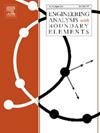Three-dimensional mesoscale analysis of the dynamic tensile behavior of concrete with heterogeneous mesostructure
IF 4.2
2区 工程技术
Q1 ENGINEERING, MULTIDISCIPLINARY
Engineering Analysis with Boundary Elements
Pub Date : 2024-10-01
DOI:10.1016/j.enganabound.2024.105982
引用次数: 0
Abstract
This paper investigates the dynamic tensile behavior of concrete under high strain rates. An optimized random concrete mesostructure generation procedure is established using the 3D entrance block (3D E(A, B)) algorithm to account for the intrinsic material heterogeneity. This approach avoids repetitive and complicated polyhedral aggregate overlapping checks in traditional methods, resulting in a highly efficient aggregate packing process. The nucleation, propagation, and coalescence of cracks are captured by a properly developed rate-dependent cohesive constitutive law. The mesoscale model is validated through comparison with experimental results. The crack evolution in the concrete under dynamic direct tensile loading conditions is explicitly presented, and the effects of the aggregate volume fraction and ITZ properties on the dynamic tensile strength enhancements are studied. The results indicate that material heterogeneity significantly influences the fracturing process and damage distribution. The dynamic tensile strength of concrete exhibits a two-strain rate regime dependence on the aggregate volume fraction concerning the strain rate. The influence of the mechanical properties of the ITZ on the dynamic tensile strength of concrete increases with the increasing strain rate.
具有异质中观结构的混凝土动态拉伸行为的三维中观分析
本文研究了混凝土在高应变速率下的动态拉伸行为。利用三维入口块(三维 E(A,B))算法建立了优化的随机混凝土中间结构生成程序,以考虑材料的内在异质性。这种方法避免了传统方法中重复而复杂的多面体骨料重叠检查,从而实现了高效的骨料堆积过程。裂缝的成核、扩展和凝聚由一个适当开发的速率依赖性内聚构成法则来捕捉。中尺度模型通过与实验结果的对比得到了验证。明确提出了混凝土在动态直接拉伸加载条件下的裂缝演变,并研究了骨料体积分数和 ITZ 特性对动态拉伸强度增强的影响。结果表明,材料的异质性对断裂过程和损伤分布有显著影响。混凝土的动态抗拉强度表现出与骨料体积分数和应变速率相关的双应变速率机制。随着应变速率的增加,ITZ 的力学性能对混凝土动态抗拉强度的影响也在增加。
本文章由计算机程序翻译,如有差异,请以英文原文为准。
求助全文
约1分钟内获得全文
求助全文
来源期刊

Engineering Analysis with Boundary Elements
工程技术-工程:综合
CiteScore
5.50
自引率
18.20%
发文量
368
审稿时长
56 days
期刊介绍:
This journal is specifically dedicated to the dissemination of the latest developments of new engineering analysis techniques using boundary elements and other mesh reduction methods.
Boundary element (BEM) and mesh reduction methods (MRM) are very active areas of research with the techniques being applied to solve increasingly complex problems. The journal stresses the importance of these applications as well as their computational aspects, reliability and robustness.
The main criteria for publication will be the originality of the work being reported, its potential usefulness and applications of the methods to new fields.
In addition to regular issues, the journal publishes a series of special issues dealing with specific areas of current research.
The journal has, for many years, provided a channel of communication between academics and industrial researchers working in mesh reduction methods
Fields Covered:
• Boundary Element Methods (BEM)
• Mesh Reduction Methods (MRM)
• Meshless Methods
• Integral Equations
• Applications of BEM/MRM in Engineering
• Numerical Methods related to BEM/MRM
• Computational Techniques
• Combination of Different Methods
• Advanced Formulations.
 求助内容:
求助内容: 应助结果提醒方式:
应助结果提醒方式:


